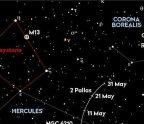Life and death in the NIGHT SKY

For years I’ve been doing astronomy outreach in schools and have heard many questions, but there was one where my own answer surprised me. While explaining how stars live and die, a youngster asked me, “How do we know that?”. Looking out of the window at a nearby field, the answer came to me: “Because stars are like the sheep out there,” I said. “Look… there’s a young lamb jumping about, a grown-up sheep eating grass, and over there by the wall there’s a dead sheep. We can see stars being born, stars that are grown up, and stars that are dying or dead, too.”
The comparison works well. We know how stars are formed, live and eventually perish because the sky is strewn with stars at different stages of their lives. After centuries of joining the temporal dots we now understand the evolution of stars fairly well – and you can see
You’re reading a preview, subscribe to read more.
Start your free 30 days





